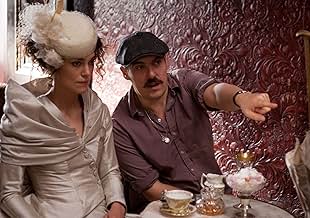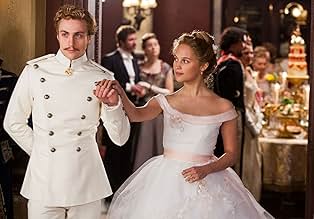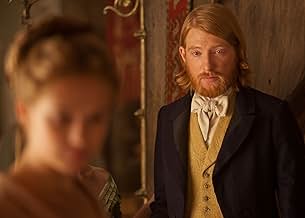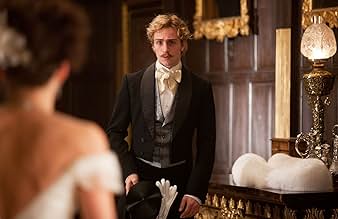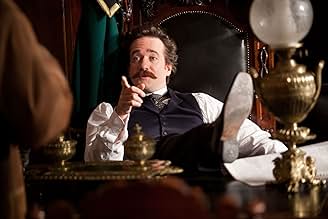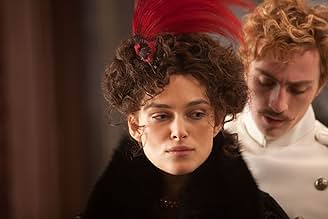In late-19th-century Russian high society, St. Petersburg aristocrat Anna Karenina enters into a life-changing affair with the dashing Count Alexei Vronsky.In late-19th-century Russian high society, St. Petersburg aristocrat Anna Karenina enters into a life-changing affair with the dashing Count Alexei Vronsky.In late-19th-century Russian high society, St. Petersburg aristocrat Anna Karenina enters into a life-changing affair with the dashing Count Alexei Vronsky.
- Won 1 Oscar
- 33 wins & 54 nominations total
- Director
- Writers
- All cast & crew
- Production, box office & more at IMDbPro
Storyline
Did you know
- TriviaOne of Alicia Vikander's favorite experiences from the production was the filming that took place in the countryside outside of St. Petersburg, Russia. The temperatures dropped below -40 °C, and she stayed in a cabin for five days that didn't have hot water and only featured benches instead of beds. Meanwhile, Russian security guards protected her and co-star 'Domhnall Gleeson' from wild wolves and bears that dominated the deserted area.
- GoofsThe label of the bottle of morphine Anna drinks from changes from "la Morphine" to "Morphine" between shots. The only correct French form would be without an article (prescriptions would have been written in Latin in 19th-century Russia anyway).
- ConnectionsFeatured in Projector: Anna Karenina (2012)
- SoundtracksSong for a New Life (Masha's Song)
(uncredited)
Written by Anoushka Shankar
Performed by Tannishtha Chatterjee
Featured review
I once asked Dustin Hoffman if he had any favorite movies or actors. He replied that he had favorite performances. Referring it seemed, to much smaller periods within a film. There are several shots where Keira is picture perfect, but this role was not for her. This performance ruins our memory of her former success under Joe Wright. Especially her first, which is her most unforgettable. Black Swan did the same for Natalie Portman, another of our cinema sweethearts. Which I walked out of.
Her part here needed to be much deeper and more complex, but instead it was shallow and trite. The way Anna was portrayed was out of place. Whether by acting or writing I don't know. Either way it was a mistake. All of the male leads, four at my count, complemented each other perfectly and were well done. Some surprising cameos among the women.
I didn't see it at the theater after hearing about the stage within the movie technique, which has actually been done in a few good movies. I didn't see it as a problem. The recent film Anonymous about Shakespeare began this way, as do others based on plays of his. Julie Taymore in her solo attempt to put Titus on film blended styles while injecting modern means and mechanism into near ancient settings, and pulled it off very smartly. Both of these were good films and highly worth watching. I point this out as there were many complaints about it in other reviews.
It isn't the blending of the modern and the ancient, or the use of multiple styles in itself that is a problem. It's more a question of whether it works, and how well it was done. I believe here it does. Peter Greenaway excels at this kind of film making. We sometimes forget how shallow we have become as a society. What a melange and patchwork our culture is. Are we surprised it shows up in our films.
There are some moments of clarity in the movie that are almost bewitching. While others present motion picture as painting or poetry. Some very good transitions. Overall I believe it to be a very creative effort. It is a blending of choreography, stage, and cinema with a desire to please the eye and entertain our emotions. It was only the moral ambiguity and modern sensibilities between the two lovers I found contemptible. Both of them being out of time and out of place.
Love is the great conquerer of lust. As lust is the great destroyer of love. I believe the author intended this to be about the second. It is a mistake to think movies from books should be the book. Just as it is wrong for an amoral people to replace the beliefs of a moral people . . with their own. Especially when borrowing or telling their stories. One of the great enjoyments for all lovers of period pieces is going back to a time when people knew morality and understood what it was, and most agreed with it. Whether or not they actually were moral is entirely . . another story.
http://fullgrownministry.wordpress.com/2013/08/04/covet/
Her part here needed to be much deeper and more complex, but instead it was shallow and trite. The way Anna was portrayed was out of place. Whether by acting or writing I don't know. Either way it was a mistake. All of the male leads, four at my count, complemented each other perfectly and were well done. Some surprising cameos among the women.
I didn't see it at the theater after hearing about the stage within the movie technique, which has actually been done in a few good movies. I didn't see it as a problem. The recent film Anonymous about Shakespeare began this way, as do others based on plays of his. Julie Taymore in her solo attempt to put Titus on film blended styles while injecting modern means and mechanism into near ancient settings, and pulled it off very smartly. Both of these were good films and highly worth watching. I point this out as there were many complaints about it in other reviews.
It isn't the blending of the modern and the ancient, or the use of multiple styles in itself that is a problem. It's more a question of whether it works, and how well it was done. I believe here it does. Peter Greenaway excels at this kind of film making. We sometimes forget how shallow we have become as a society. What a melange and patchwork our culture is. Are we surprised it shows up in our films.
There are some moments of clarity in the movie that are almost bewitching. While others present motion picture as painting or poetry. Some very good transitions. Overall I believe it to be a very creative effort. It is a blending of choreography, stage, and cinema with a desire to please the eye and entertain our emotions. It was only the moral ambiguity and modern sensibilities between the two lovers I found contemptible. Both of them being out of time and out of place.
Love is the great conquerer of lust. As lust is the great destroyer of love. I believe the author intended this to be about the second. It is a mistake to think movies from books should be the book. Just as it is wrong for an amoral people to replace the beliefs of a moral people . . with their own. Especially when borrowing or telling their stories. One of the great enjoyments for all lovers of period pieces is going back to a time when people knew morality and understood what it was, and most agreed with it. Whether or not they actually were moral is entirely . . another story.
http://fullgrownministry.wordpress.com/2013/08/04/covet/
- onewhoseesme
- Jun 22, 2013
- Permalink
- How long is Anna Karenina?Powered by Alexa
Details
- Release date
- Countries of origin
- Official site
- Language
- Also known as
- Chuyện Tình Anna
- Filming locations
- Kizhi, Karelia, Russia(on location)
- Production companies
- See more company credits at IMDbPro
Box office
- Budget
- $40,600,000 (estimated)
- Gross US & Canada
- $12,816,367
- Opening weekend US & Canada
- $320,690
- Nov 18, 2012
- Gross worldwide
- $68,929,150
- Runtime2 hours 9 minutes
- Color
- Sound mix
- Aspect ratio
- 2.35 : 1
Contribute to this page
Suggest an edit or add missing content














